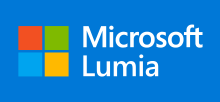Lumia Black
 |
|

Microsoft Lumia logo (Top) and various Nokia and Microsoft branded Lumia devices (Bottom). From left to right, the Lumia 1320, the Lumia 535, and the Lumia 530.
|
|
| Manufacturer |
Microsoft Mobile (2014–present) Nokia (2011–2014) |
|---|---|
| Availability by country | November 2011 (Europe) January 2012 (elsewhere) |
| Related |
List of Windows 10 Mobile devices List of Windows Phone devices List of Nokia products |
| Type | Smartphone, Phablet, Tablet |
| Form factor | Bar |
| Operating system | Windows 10 Mobile, Windows Phone |
| CPU | Qualcomm Snapdragon |
| Data inputs | Touchscreen |
| Development status | Production ceased |
| Website | www |
Microsoft Lumia (previously the Nokia Lumia Series) is a range of mobile devices designed and marketed Microsoft Mobile and previously by Nokia. Introduced in November 2011, the line was the result of a long-term partnership between Nokia and Microsoft—as such, most Lumia smartphones run the Windows Phone operating system, excluding some later models which run the newer Windows 10 Mobile. The Lumia name is derived from the partitive plural form of the Finnish word , meaning "snow".
On 3 September 2013, Microsoft announced its purchase of Nokia's mobile device business, with the deal closing on 25 April 2014. As a result, the Lumia line's maintenance was transferred to Microsoft Mobile. As part of the transition, Microsoft continued to use the Nokia brand on Lumia devices until October 2014, when it began to officially phase out the Nokia name in its promotion and production of smartphones in favor of Microsoft branding. In November 2014, Microsoft announced the first Microsoft (non-Nokia) branded Lumia device, the Lumia 535. In October 2015, Microsoft announced the first Lumia devices running on Windows 10 Mobile, the Lumia 950, Lumia 950 XL and Lumia 550. The most recent Lumia smartphone, the Lumia 650, was announced by Microsoft on February 15, 2016.
Sales decreased sharply after the introduction of Windows 10 in 2015 and Microsoft briefly stopped selling Lumia devices from the Microsoft Store at the end of 2016, although availability was restored at the beginning of 2017.
From 1998 to 2012, Nokia was the largest vendor of mobile phones in the world, which included early smartphones built on its Symbian platform. However, in recent years, its market share declined as a result of the growing use of touchscreen smartphones from other vendors, such as Apple's iPhone line and Android-based products. In 2010, its market share had declined to 28%, and in April 2012, Samsung Electronics (a prominent user of Android) ultimately overtook Nokia as the largest mobile phone vendor in the world. Nokia's CEO Stephen Elop vetoed the idea of producing Android devices, believing the company wouldn't be able to suitably differentiate its Android products from that of other vendors. In an employee memo, Elop infamously described the company as being on a "burning platform", blaming the "war of ecosystems" between iOS and Android as part of Nokia's overall struggle, and asserting that the company needed to make major changes to its operation.
...
Wikipedia
